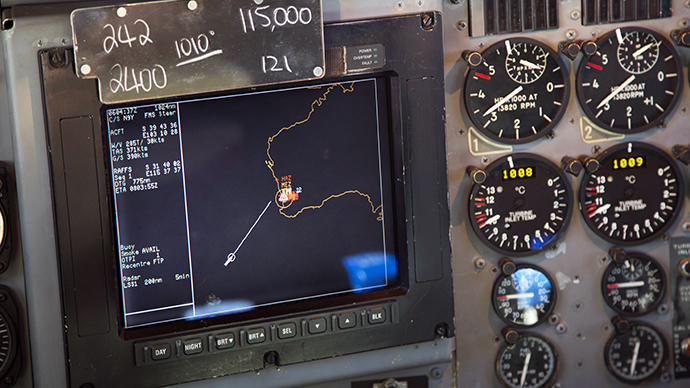Hunt for Malaysian airliner shifts following new leads

An international search for Malaysian Airlines flight MH370 was redirected 1,100km (680 miles) to the northeast on Friday, after new analysis suggests the aircraft had run out of fuel earlier than previously estimated.
In what could be the last hopeful lead for finding Malaysian
flight MH370, which disappeared from radar on March 8 with 239
passengers on board, analysts now believe the aircraft was
traveling faster than previously estimated, which would have
caused the plane to use its fuel faster, thus reducing the
distance it traveled before going down in the Indian Ocean.
The shift in the search for the Malaysian jetliner comes one day
after Japanese and Thai analysts retrieved updated satellite
images showing large debris fields that could be wreckage from
the plane. The find was backed up by earlier sightings in the
same region by French, Chinese and US satellites that reported
over 100 spotted objects.
Following the delay of operations on Thursday due to poor weather
conditions, the search teams are resuming their hunt on Friday.
Four search aircraft were patrolling the new search area while
six vessels were headed there, said John Young, manager of
Australian Maritime Safety Authority (AMSA) emergency response
division. “We have moved on” from the previous search
zone, he said.
AMSA said a search plane had located objects in the new search zone and is awaiting images from the Royal New Zealand Air Force Orion, which is heading back to its base in Perth. The findings would then need to be confirmed by ship, which was not expected until Saturday, AMSA said in its official twitter feed.
Prior to the latest recalculations, the search had focused for
about a week painstakingly hunting for the proverbial needle in
the haystack about 2,500km (1,550 miles) southwest of Perth,
Australia. On the basis of the new information, the search has
moved to within 1,850km (1,150 miles) west of the city.
“This is our best estimate of the area in which the aircraft
is likely to have crashed into the ocean,” Martin Dolan,
chief commissioner of the Australian Transport Safety Bureau,
said at a news conference in Canberra.
The immense size of the search area presents search teams with a
formidable challenge: about 319,000 sq kms (123,000 sq miles).
Sea depths in the new zone range from 2,000 meters (6,560 feet)
to 4,000 meters (13,120 feet), Young said.
In order to arrive at the new coordinates, Dolan explained the
analysts are “looking at the data from the so-called pinging
of the satellite, the polling of the satellites, and that gives a
distance from a satellite to the aircraft to within a reasonable
approximation.” Other factors must also be taken into
account to arrive at the aircraft’s location, including the
plane’s distance from the satellites at given times.
Dolan said the search now is for surface debris to give an
indication of ‘‘where the main aircraft wreckage is likely to
be. This has a long way to go.’’
Young attempted to deflect criticism from the search efforts,
which have been plagued with a number of perplexing setbacks.
“This is the normal business of search and rescue operations
— that new information comes to light, refined analyses take you
to a different place,” Young told reporters. “I don’t
count the original work as a waste of time.”
Australian Prime Minister Tony Abbott said Friday that the latest
information was ‘‘a credible new lead.’’
‘‘This is an extraordinarily difficult search, and an agonizing
wait for family and friends of the passengers and crew,’’ he
said. ‘‘We owe it to them to follow every credible lead and
to keep the public informed of significant new developments. That
is what we are doing.’’
Meanwhile, as Malaysian officials remain optimistic that the
aircraft will be recovered, the string of setbacks and delays in
the search has provoked anxiety and even outrage among the family
members of the passengers, who were informed this week by
Malaysian officials that there was “sealed evidence” in regard to
the missing flight that cannot be disclosed.
“The sealed evidence included air traffic control radio
transcript, radar data and airport security recordings,” the
Straits Times reported
This week, about 100 distraught friends and relatives of the
missing Chinese, wearing white T-shirts emblazoned with ‘Let’s
pray for MH370’ engaged in a demonstration at the Malaysian
embassy. Some hurled water bottles and tried to rush the gates
while chanting “Liars!” and “Malaysia, return our relatives!”
“We demand the Malaysian side make clear the specific basis
on which they come to this judgment,” Chinese Deputy Foreign
Minister Xie Hangsheng on Wednesday told Malaysia’s ambassador to
Beijing.
However, the race against time is also critical for not only
determining the location of the aircraft, but for finding the
nearly indestructible black boxes, which provide investigators
all the information they need to make an accurate assessment as
to what caused a plane to experience in-flight problems.
The black boxes have enough battery life to last just 30 days,
giving the search teams a little over a week to locate them while
still active.














